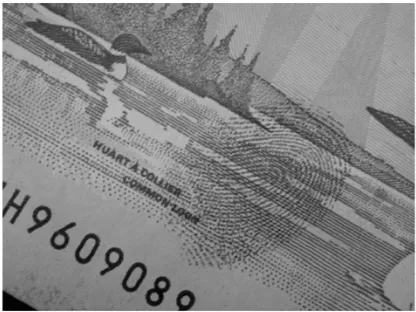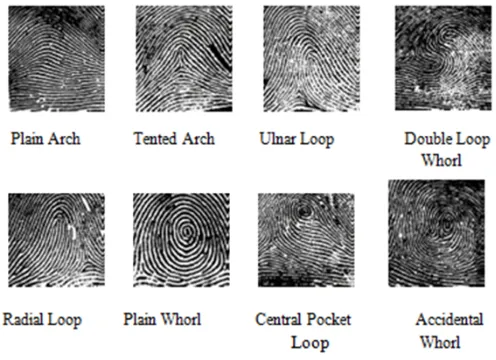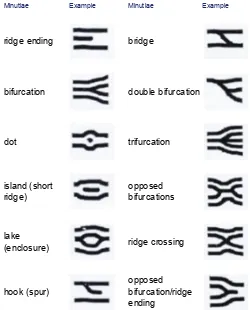© 2016, IJCSMC All Rights Reserved 60 Available Online atwww.ijcsmc.com
International Journal of Computer Science and Mobile Computing
A Monthly Journal of Computer Science and Information Technology
ISSN 2320–088X
IMPACT FACTOR: 5.258
IJCSMC, Vol. 5, Issue. 8, August 2016, pg.60 – 65
Fingerprint Identification for Forensic
Crime Scene Investigation
Asan Baker Kanbar
Computer Science, Cihan University/Sulaimaniya, Iraq
esenturkay@hotmail.com
Abstract: Fingerprints are the most widely used biometric feature for person identification and verification in the field of biometric identification. This paper presents the implementation of a minutiae based approach to fingerprint identification and verification of the fingerprint image captured at the crime scene. Digital evidence enhancement techniques, such as Fast Fourier Transform and Image Subtraction, have been described in detail.
Keywords: Fingerprint, Fast Fourier Transform, filtering, Fast Fourier Transform, Image Subtraction, minutiae
I. Introduction
© 2016, IJCSMC All Rights Reserved 61
The first step for image enhancement in this type of situation is to remove the regular patterns, or the background, from the image. The Fast Fourier Transform (FFT) is used to remove the regular patterns from the image. An example of removing the background through FFT is shown in fig. 1, which shows a finger print on a form of currency. By removing the wavy parts of the currency from the image, it’s easier to collect the finger print [2].
When a FFT is not suitable to the particular situation, the background can also be removed by finding regular patterns on the image and subtracting the m fro m the original. This is done by finding a number of identifying marks on each image, lining the marks up, and subtracting the two images.
An example of background subtraction is given in Fig. 2 and Fig.3. This image is better suited for image subtraction than for FFT because the background is very complex and fairly random. After that there are many options to enhance the image to obtain the best possible picture of the forensic evidence. One such method is to invert the image and adjust it for contrast. Other corrections such as brightness and gamma adjustments can be applied if necessary [2].
Fig. 1 Image before and after FFT to remove the background.
© 2016, IJCSMC All Rights Reserved 62 III. Fingerprint Identification Using Minutiae Matching
Fingerprint image enhancement and minutiae matching are two key steps in an automatic fingerprint identification system. Fingerprint Identification is the method of identification using the impressions made by the minute ridge formations or patterns found on the fingertips. No two persons have exactly the same arrangement of ridge patterns, and the patterns of any one individual remain unchanged throughout life [3],[4]. Fingerprints offer an infallible means of personal identification. Other personal characteristics may change, but fingerprints do not. In general, we use minutiae such as ridge endings and ridge bifurcation to represent a fingerprint and do fingerprint matching through minutiae matching. Fig.4 shows Fingerprint Pattern Type
Fig.4 Fingerprint Pattern Type
© 2016, IJCSMC All Rights Reserved 63
This system consists of two phases template storing and matching phases. After using FFT or Image subtraction to get the fingerprint. In template storing phase, a fingerprint is acquired, enhanced using different algorithms, where after features of the fingerprint are extracted and stored in a database as a template. In the matching phase, a fingerprint is acquired, enhanced and features of the fingerprint are extracted, fed to a matching model and matched against template. This system is shown in fig.5.
Fig.5 Flowchart of fingerprint identification system
© 2016, IJCSMC All Rights Reserved 64
Minutiae Example Minutiae Example
ridge ending bridge
bifurcation double bifurcation
dot trifurcation
island (short ridge)
opposed bifurcations
lake
(enclosure) ridge crossing
hook (spur)
opposed bifurcation/ridge ending
Fig. 6 Basic and composite ridge characteristics (minutiae)
© 2016, IJCSMC All Rights Reserved 65
independently upon which to base a conclusion of either elimination or identity. If the areas between these areas can be clarified so that the continuity of the ridges is unbroken, a significant opinion may be formed that would otherwise have not been possible.
IV. Conclusion
Image enhancement is a key tool for forensic investigators when searching for evidence at a crime scene. It can be invaluable for evidence that is faint and tough to make out. It is usually necessary for investigators to be able to get rid of the background, which can be done by FFT or background subtraction. Investigators can use many different options for further enhancement, including gamma corrections, contrast stretching, and histogram equalization. By doing these following methods, forensic investigators can obtain the best possible evidence from a crime scene. Also the paper presents an overview of the different steps involved in the development of fingerprint based person identification and verification using minutiae based system.
References
[1] Brian Dalrymple, Len Shaw KeithWoods; Optimized Digital Recording of Crime Scene Impressions, Journal of Forensic Identification750 / 52 (6), 2002
[2] Brian Dalrymple ;Background Subtraction Through Exhibit Substitution, Journal of Forensic Identification 150 / 54 (2), 2004
[3] Dalrymple, B.; Shaw, L.; Woods K.; Optimized Digital Recording of Crime Scene Impressions. J. For. Ident. 2002,52 (6), 750-761.
[4]F.A. Afsar, M. Arif and M. Hussain; Fingerprint Identification and Verification System using Minutiae Matching; National Conference on Emerging Technologies 2004
[5] Masahiro TAKEDA*, Satoshi UCHIDA; Finger Image Identification Method for Personal Verification; CH2898-5/90/0000/0761$01,.1990 IEEE


